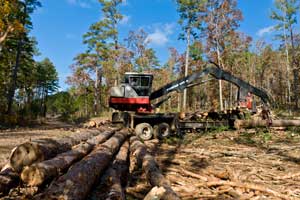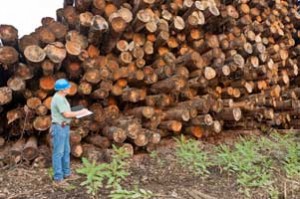From the time the very first Europeans set foot on American soil, we have tried to develop systems to estimate the board feet of finished lumber we can obtain from a green log. It seems straightforward: figure the number of 1-inch thick planks that can be sawn, subtract for the width of the saw blade (kerf) and for waste (trim), and there you would have it, what is known as a “log rule.” However, it i s not that simple, because that does not take into consideration the high variability between logs, equipment used to saw those logs, and the operators of that equipment. The Forest Service’s Forest Products Lab in Madison, Wisconsin reports that over 95 log rules with about 185 different names have been developed in our brief history as a nation.
s not that simple, because that does not take into consideration the high variability between logs, equipment used to saw those logs, and the operators of that equipment. The Forest Service’s Forest Products Lab in Madison, Wisconsin reports that over 95 log rules with about 185 different names have been developed in our brief history as a nation.
The three most popular log rules used in modern forestry are the Doyle, Scribner, and International ¼. A typical log rule is an equation that seeks to estimate board feet of lumber from a log. This is the Doyle Rule:
Board Feet = (Diameter at small end – 4)2 x Length of Log/16
The Doyle log rule was developed by Edward Doyle and first published in Rochester, New York in 1825. This rule allowed for a 5/16 saw kerf and a 4″ slab allowance which is quit high. It was eventually replaced in the Western U.S. by the Scribner Rule, developed in 1846 by J. M. Scribner.
Scribner’s rule was based on a diagram where the actual boards, kerf, and waste were drawn in a circle of the diameter equal to the log, so all formulas subsequently developed to explain it were diameter-specific. The Scribner rule is now used mainly west of the Mississippi River and along the Rocky Mountains and Pacific. This rule does not allow for taper in the log, so any lumber recovered from the slabs cut off to square up the log are not counted. This bias becomes more pronounced as log length increases.
The International rule was developed by Judson F. Clark in 1900. The rule was developed to more accurately allow for saw kerf, waste and log taper. It worked on logs in multiples of 4 feet as there is a different equation for each length from 4 feet to 20 feet. In 1917 Clark updated his International Rule to the International ¼ Rule since most mills during that time were using saws that were not capable of the narrow 1/8-inch kerf his original rule assumed. Although this rule most accurately predicts the actual yield of lumber from logs, it has not gained widespread use.
To illustrate the wide variance in lumber predictions among the three rules, take a log that is 16″ in diameter at the small end, and 16′ long with a value of $500 per thousand board feet. The following table reflects the volume and values based on the three log rules we have discussed.
| Log Diameter (in.) | Log Rule |
Predicted Volume (board feet) |
Value ($) |
|
16 |
International |
180 |
90.00 |
|
16 |
Scribner Decimal C |
160 |
80.00 |
|
16 |
Doyle |
144 |
72.00 |
Adapted from: Forest Landowner’s Guide to the Measurement of Timber and Logs, ID
Authors as Published
James E. Johnson, Extension Forester, Virginia Tech
So, you can see that if a buyer bought a log from a land owner using the Doyle log rule, and then sold it to you for the exact same price per board foot but used the International rule to sell it, he would make a tidy 25 percent profit on the transaction with no change in price.
Next time … why the log rules are important to you.
Tim Knight





